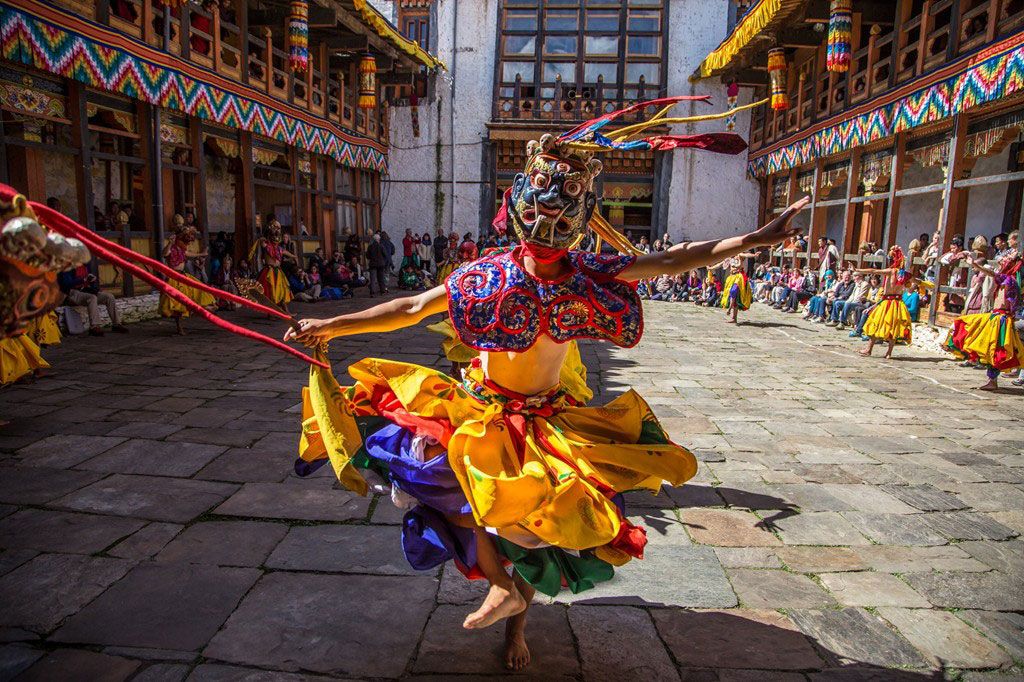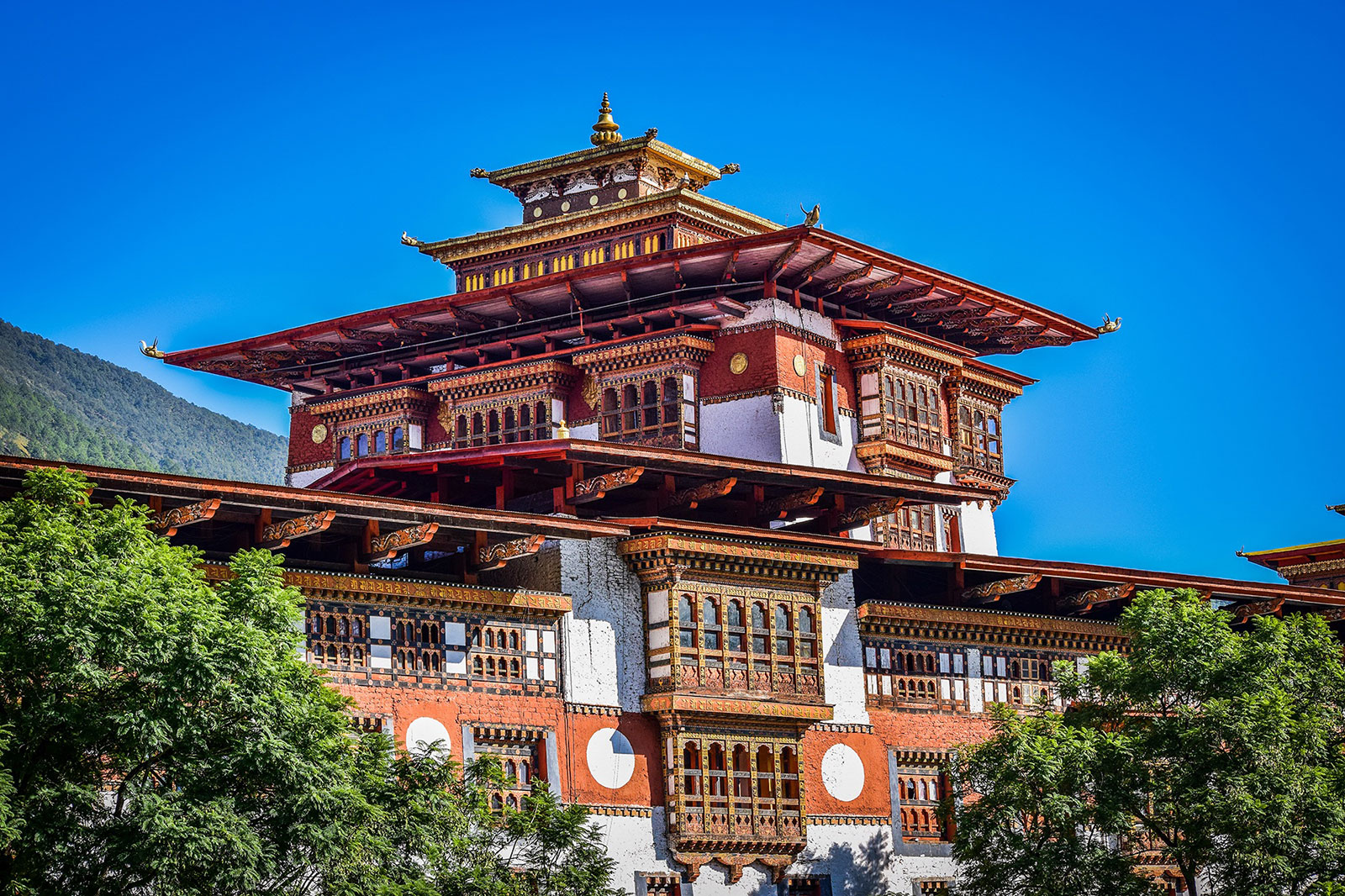For visitors planning a trip to Bhutan less than a week, we recommend the tour package “Tour Flavor of Bhutan. It is an ideal and quick way to experience the glory and the myth of Bhutan. This tour package can serve as an extension of trip for travelers in South East Asia who would like to make short visit in Bhutan. The extension can be before or after your trip in any of the South East Asian countries.
Day 01: Paro – Thimphu (Two-hour drive)
In clear days, Druk Air’s flight to Bhutan provides a wonderful view of Himalayan scenery. Whether flying along the Himalayan range from Kathmandu or over the foothills from Kolkata, it is a breathtaking journey above forested hills into the hidden Shangrila.
At the Paro airport, Bhutan Creative Tours representative will receive you. After completing the airport formalities, you will experience an interesting two-hour drive along the winding highway to Thimphu, the capital town of Bhutan.
Overnight – hotel in Thimphu.
Day 02: Thimphu – Punakha
Thimphu (2400m) is the only city in the world without traffic lights. It is the seat of government. This bustling town is home to Bhutan’s royal family, civil servants, and foreign missions in Bhutan. It is also the headquarters for a number of internationally funded development projects.
In the morning, you will visit the National Library, which has an extensive collection of Buddhist literatures, with some works dating back several hundred years. You will also visit the Institute for Zorig Chusum (commonly known as the Painting School), where a six-year training course is given on 13 traditional arts and crafts of Bhutan and the National Institute of Traditional Medicine, where the medicinal herbs abundant in the kingdom are compounded and dispensed.
After lunch, you will visit the National Memorial Chorten. The third king, His Majesty Jigme Dorji Wangchuck, who wanted to erect a monument to world peace and prosperity, originally planned the building of this landmark. After his untimely demise, the fourth king, His Majesty Jigme Singye Wangchuk completed the construction in 1974. It is both a memorial to the Late King (“the father of modern Bhutan”), and a monument to peace. You will also visit the government-run Handicrafts Emporium and privately owned crafts shops, which offer a wide range of local products, including the splendid thangkha paintings and exquisitely woven textiles. Thereafter, we will take you to the Folk Heritage and National Textile Museums, opened in 2001.
Late afternoon drive to Punakha, the road from Thimphu to Punakha goes northeast and one of the highlights of the journey is at Dochu La Pass (3050m), the highest point between Thimphu and Punakha. From here when the sky is clear, one can enjoy a spectacular and panoramic view of the snow-capped peaks to the north that are above 7000m. The pass has 108 chortens (Stupa), honoring those who laid down their lives while flushing out insurgents from southern Bhutan in December 2003. Chortens are Buddhist reliquaries and memorials to the teachings of the Buddha. Sometimes, stupas carry relics of the Buddha or revered monks. Whether or not there are relics inside, the stupas mark the landscape with reminders of the Buddha’s teachings.
Overnight – hotel in Punakha.
Day 03: Punakha – Wangduephodrang – Paro
Punakha (1300m) served as the capital of Bhutan until 1955 before the seat of government moved to Thimphu. The original town is on the riverbank dominated by the towering walls of Punakha Dzong. After extensive flooding in 1994, the town shifted to a safer site about a few kilometers from the dzong. At the same time, Punakha Dzong underwent extensive renovation, which is now a breathtaking and glorious sight as you first glimpse it from the road. Although, four catastrophic fires and an earthquake in the past destroyed many historic documents, Punakha Dzong still houses many sacred and historic artifacts and the embalmed body of Zhabdrung Ngawang Namgyal.
Later drive to Wangduephodrang (1300m), the last town on the highway before entering central Bhutan. Situated on a ridge overlooking a river junction, the formidable Wangduephodrang Dzong is the town’s most visible feature. In the 17th century, Wangduephodrang played a critical role in unifying the western, central and southern regions of the country. Also, visit the local market.
After lunch, we shall drive back to Paro. En route, make a brief stop at the Royal Botanical Garden if time permits.
Overnight – hotel in Paro.
Day 04: Paro (2300m)
The Paro valley has attractives sites to visit. In the morning, you will visit Ta Dzong; once a watchtower, built to defend Rinpung Dzong during inter-valley wars of the 17th century. Ta Dzong became the Bhutan’s National Museum in 1968.
Next visit is Rinpung Dzong. Zhabdrung Ngawang Namgyal, the first spiritual and temporal ruler of Bhutan, built the dzong in 1646; the dzong continues its age-old function as the seat of the district administration, district court and the monastic body. The southern approach to the dzong has a traditional roofed cantilever bridge called Nemi Zam. A walk across the bridge offers a spectacular view of dzong’s architecture and an opportunity to tread the same path as the ancient warriors. “Little Buddha”, the Hollyhwood movie has captured the beauty and splendour of Rinpung Dzong and Nemi Zam.
After lunch, you will have 18 km drive from Paro town towards the northern valley to view the ruins of Drukgyel Dzong (victory fortress). Drugyal Dzong is a well-known place from where the Bhutanese fought back several invading Tibetan armies in the 17th century. Unfortunately, the fire that started from a butter lamp destroyed the dzong in 1951. The ruins that depict the past war strategies of Bhutanese army and the ancient lifestyle of a farming community are still a tourist attraction.
In addition, you will visit Kyichu Lhakhang, one of 108 lhakhangs built in 7th century by the Tibetan king, Songtsen Gampo. Legend has it that king Songtsen Gampo built Kyichu Lhakhang on the right foot of a demon. It is now the oldest and most sacred shrine in the kingdom.
In the evening, you will visit traditional farmhouses for an opportunity to interact with the local families and learn more about their lifestyle. Later, you can take an evening stroll along the main street, and perhaps visit a few handicrafts shops, or take refreshments at a local café or bar.
Overnight -hotel in Paro.
Day 05: Depart Paro
After breakfast, drive to the airport for your onward flight. Your escort from Bhutan Creative Tours will bid you farewell and soon you will see the remote and legendary Dragon Kingdom disappear behind its guardian mountains.









